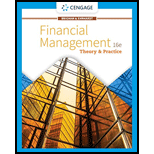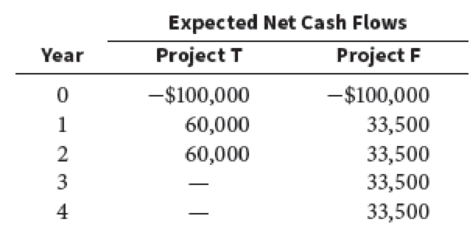
Financial Management: Theory & Practice
16th Edition
ISBN: 9781337909730
Author: Brigham
Publisher: Cengage
expand_more
expand_more
format_list_bulleted
Concept explainers
Textbook Question
Chapter 10, Problem 11MC
In an unrelated analysis, you have the opportunity to choose between the following two mutually exclusive projects, Project T (which lasts for 2 years) and Project F (which lasts for 4 years):

The projects provide a necessary service, so whichever one is selected is expected to be repeated into the foreseeable future. Both projects have a 10% cost of capital.
- (1) What is each project’s initial
NPV without replication? - (2) What is each project’s equivalent annual
annuity ? - (3) Apply the replacement chain approach to determine the projects’ extended NPVs. Which project should be chosen?
- (4) Assume that the cost to replicate Project T in 2 years will increase to $105,000 due to inflation. How should the analysis be handled now, and which project should be chosen?
Expert Solution & Answer
Want to see the full answer?
Check out a sample textbook solution
Students have asked these similar questions
Explain why long-term bonds are subject to greater interest rate risk than short-term bonds with references or practical examples.
What does it mean when a bond is referred to as a convertible bond? Would a convertible bond be more or less attractive to a bond holder than a non-convertible bond? Explain in detail with examples or academic references.
Alfa international paid $2.00 annual dividend on common stock and promises that the dividend will grow by 4% per year, if the stock’s market price for today is $20, what is required rate of return?
Chapter 10 Solutions
Financial Management: Theory & Practice
Ch. 10 - Define each of the following terms:
Capital...Ch. 10 - What types of projects require the least detailed...Ch. 10 - Explain why the NPV of a relatively long-term...Ch. 10 - When two mutually exclusive projects are being...Ch. 10 - Suppose a firm is considering two mutually...Ch. 10 - A project has an initial cost of 40,000, expected...Ch. 10 - Refer to Problem 10-1. What is the project’s IRR?
Ch. 10 - Refer to Problem 10-1. What is the projects MIRR?Ch. 10 - Prob. 4PCh. 10 - Prob. 5P
Ch. 10 - Prob. 6PCh. 10 - Your division is considering two investment...Ch. 10 - Edelman Engineering is considering including two...Ch. 10 - Davis Industries must choose between a gas-powered...Ch. 10 - Project S has a cost of 10,000 and is expected to...Ch. 10 - Your company is considering two mutually exclusive...Ch. 10 - Prob. 12PCh. 10 - Cummings Products is considering two mutually...Ch. 10 - Prob. 14PCh. 10 - Prob. 15PCh. 10 - Shao Airlines is considering the purchase of two...Ch. 10 - The Perez Company has the opportunity to invest in...Ch. 10 - Filkins Fabric Company is considering the...Ch. 10 - Prob. 19PCh. 10 - The Aubey Coffee Company is evaluating the...Ch. 10 - Your division is considering two investment...Ch. 10 - Prob. 22PCh. 10 - Start with the partial model in the file Ch10 P23...Ch. 10 - What is capital budgeting?Ch. 10 - Prob. 2MCCh. 10 - c. (1) Define the term net present value (NPV)....Ch. 10 - Prob. 4MCCh. 10 - Draw NPV profiles for Franchises L and S. At what...Ch. 10 - What is the underlying cause of ranking conflicts...Ch. 10 - Define the term modified IRR (MIRR). Find the...Ch. 10 - What does the profitability index (PI) measure?...Ch. 10 - (1) What is the payback period? Find the paybacks...Ch. 10 - Prob. 10MCCh. 10 - In an unrelated analysis, you have the opportunity...Ch. 10 - You are also considering another project that has...
Knowledge Booster
Learn more about
Need a deep-dive on the concept behind this application? Look no further. Learn more about this topic, finance and related others by exploring similar questions and additional content below.Similar questions
- General Financearrow_forwardAs CFO for Everything.Com, you are shopping for 6,000 square feet of usable office space for 25 of your employees in Center City, USA. A leasing broker shows you space in Apex Atrium, a 10-story multitenanted office building. This building contains 360,000 square feet of gross building area. A total of 54,000 square feet is interior space and is nonrentable. The nonrentable space consists of areas contained in the basement, elevator core, and other mechanical and structural components. An additional 36,000 square feet of common area is the lobby area usable by all tenants. The 6,000 square feet of usable area that you are looking for is on the seventh floor, which contains 33,600 square feet of rentable area, and is leased by other tenants who occupy a combined total of 24,000 square feet of usable space. The leasing broker indicated that base rents will be $30 per square foot of rentable area Required: a. Calculate total rentable area in the building as though it would be rented to…arrow_forwardDon't used Ai solutionarrow_forward
- General Finance Questionarrow_forwardConsider the following simplified financial statements for the Yoo Corporation (assuming no income taxes): Income Statement Balance Sheet Sales Costs $ 40,000 Assets 34,160 $26,000 Debt Equity $ 7,000 19,000 Net income $ 5,840 Total $26,000 Total $26,000 The company has predicted a sales increase of 20 percent. Assume Yoo pays out half of net income in the form of a cash dividend. Costs and assets vary with sales, but debt and equity do not. Prepare the pro forma statements. (Input all amounts as positive values. Do not round intermediate calculations and round your answers to the nearest whole dollar amount.) Pro forma income statement Sales Costs $ 48000 40992 Assets $ 31200 Pro forma balance sheet Debt 7000 Equity 19000 Net income $ 7008 Total $ 31200 Total 30304 What is the external financing needed? (Do not round intermediate calculations. Negative amount should be indicated by a minus sign.) External financing needed $ 896arrow_forwardAn insurance company has liabilities of £7 million due in 10 years' time and £9 million due in 17 years' time. The assets of the company consist of two zero-coupon bonds, one paying £X million in 7 years' time and the other paying £Y million in 20 years' time. The current interest rate is 6% per annum effective. Find the nominal value of X (i.e. the amount, IN MILLIONS, that bond X pays in 7 year's time) such that the first two conditions for Redington's theory of immunisation are satisfied. Express your answer to THREE DECIMAL PLACES.arrow_forward
- An individual is investing in a market where spot rates and forward rates apply. In this market, if at time t=0 he agrees to invest £5.3 for two years, he will receive £7.4 at time t=2 years. Alternatively, if at time t=0 he agrees to invest £5.3 at time t=1 for either one year or two years, he will receive £7.5 or £7.3 at times t=2 and t=3, respectively. Calculate the price per £5,000 nominal that the individual should pay for a fixed-interest bond bearing annual interest of 6.6% and is redeemable after 3 years at 110%. State your answer at 2 decimal places.arrow_forwardThe one-year forward rates of interest, f+, are given by: . fo = 5.06%, f₁ = 6.38%, and f2 = 5.73%. Calculate, to 4 decimal places (in percentages), the three-year par yield.arrow_forward1. Give one new distribution channels for Virtual Assistance (freelance business) that is not commonly used. - show a chart/diagram to illustrate the flow of the distribution channels. - explain the rationale behind it. (e.g., increased market reach, improved customer experience, cost-efficiency). - connect the given distribution channel to the marketing mix: (How does it align with the overall marketing strategy? Consider product, price, promotion, and place.). - define the target audience: (Age, gender, location, interests, etc.). - lastly, identify potential participants: (Wholesalers, retailers, online platforms, etc.)arrow_forward
arrow_back_ios
SEE MORE QUESTIONS
arrow_forward_ios
Recommended textbooks for you
 Intermediate Financial Management (MindTap Course...FinanceISBN:9781337395083Author:Eugene F. Brigham, Phillip R. DavesPublisher:Cengage Learning
Intermediate Financial Management (MindTap Course...FinanceISBN:9781337395083Author:Eugene F. Brigham, Phillip R. DavesPublisher:Cengage Learning

Intermediate Financial Management (MindTap Course...
Finance
ISBN:9781337395083
Author:Eugene F. Brigham, Phillip R. Daves
Publisher:Cengage Learning

Capital Budgeting Introduction & Calculations Step-by-Step -PV, FV, NPV, IRR, Payback, Simple R of R; Author: Accounting Step by Step;https://www.youtube.com/watch?v=hyBw-NnAkHY;License: Standard Youtube License